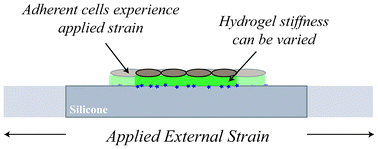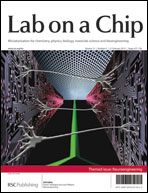Formation of composite polyacrylamide and silicone substrates for independent control of stiffness and strain†
Abstract
Cells that line major tissues in the body such as blood vessels, lungs and gastrointestinal tract experience deformation from mechanical strain with our heartbeat, breathing, and other daily activities. Tissues also remodel in both development and disease, changing their mechanical properties. Taken together, cells can experience vastly different mechanical cues resulting from the combination of these interdependent stimuli. To date, most studies of cellular mechanotransduction have been limited to assays in which variations in substrate stiffness and strain were not combined. Here, we address this technological gap by implementing a method that can simultaneously tune both substrate stiffness and mechanical strain. Substrate stiffness is controlled with different monomer and crosslinker ratios during polyacrylamide gel polymerization, and strain is transferred from the underlying silicone platform when stretched. We demonstrate this platform with polyacrylamide gels with elastic moduli at 6 kPa and 20 kPa in combination with two different silicone formulations. The gels remain attached with up to 50% applied strains. To validate strain transfer through the gels into cells, we employ particle-tracking methods and observe strain transmission via cell morphological changes.


 Please wait while we load your content...
Please wait while we load your content...